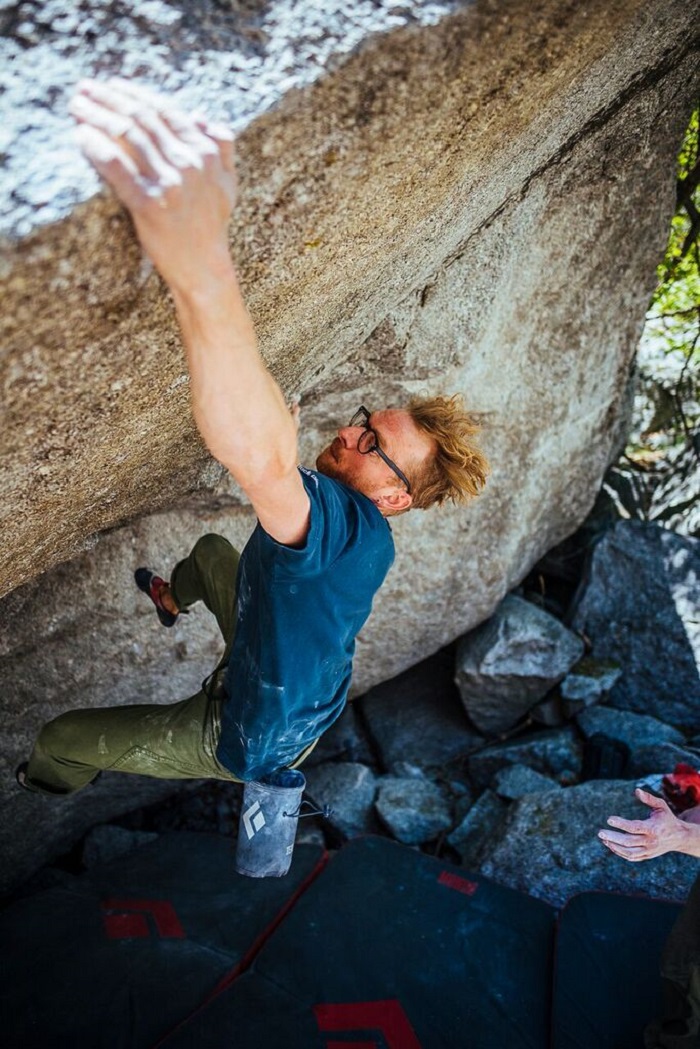
When he’s not setting up store openings and trade shows displays as a visual designer for outdoor retail giant Patagonia, you can find Justin Wood hanging by his fingertips at the world’s most renowned bouldering competitions. As a bouldering guru, Justin is a known quantity in the climbing community, especially in Utah.
Bouldering is a sport in which climbers scale boulders and rock formations without the aid of ropes or harnesses. You have probably seen those artificial climbing walls at gyms and various outdoor gear establishments where anyone can test their climbing prowess by ascending a wall with an overhanging incline and make it look easy.
But whereas newbie climbers use ropes to keep from falling, professionals like Justin rely on years of skill and a tenacious grip to maintain contact with rock faces that would scare most mortals into keeping our feet planted firmly on the ground.
Justin’s foray into bouldering began at the age of 15 on the granite slabs in Little Cottonwood Canyon. “My uncle first introduced me to climbing,” Justin recalls. “He climbed here back in the 60s. He had a pair of old climbing shoes and we went bouldering. Little Cottonwood Canyon has amazing bouldering and trad [traditional] climbing.”
Using little more than specialized shoes, climbers employ strategy and skill to solve the technical problems of advanced bouldering, which, for safety reasons, seldom exceed 6 meters in height. Foam mats known as Crash Pads are the only buffer between a slip and a hard landing if a climber loses his grip at 20 feet above the ground, although injuries at the professional level are rare.
As his skills grew, Justin gained sponsorships and endorsements, which helped with travel expenses. “There’s not a lot of money in climbing,” he tells me, “but there are a handful of people who do pretty well.”
Our unique geology makes Utah a climber’s paradise, but a quest for more temperate climates keeps dedicated climbers on the move. At one time, Justin lived out of a van so he could follow the seasonal circuit from Utah to Waco Tanks, Texas, to Suquamish, Washington, and other North American bouldering meccas.
“But Fontainebleau, in France, is my favorite bouldering area in the world,” Justin says. “It has sandstone boulders in a prehistoric lake bed about 50 kilometers south of Paris. It’s all in the woods. It’s pretty incredible. It’s not like the red sandstone we have down south. Generally speaking, the texture is pretty similar, but it’s really fine-grained sand, and it’s a little bit harder. It has a dark green-gray patina on it so it looks totally different. It’s really insane. It’s the best climbing area I’ve ever seen.”
Bouldering provides tremendous strength-building benefits. Beginners will want to start indoors and progress at their own comfort level. Learning how to fall correctly and having a spotter will help prevent injury.
When asked what climbing does for him, Justin says, “I’m so addicted to the movements and to climbing itself that I don’t even think about why I do it. I just need to do it. If I go too many days without climbing, I get a little antsy. At this point I’ve been climbing 21 years, and it was such a passion, especially in my 20s, that it drove everything I did. Almost all my lifestyle decisions are climbing-based. I like having that regular, almost meditative movement. It’s all about focus and sticking with it.”





